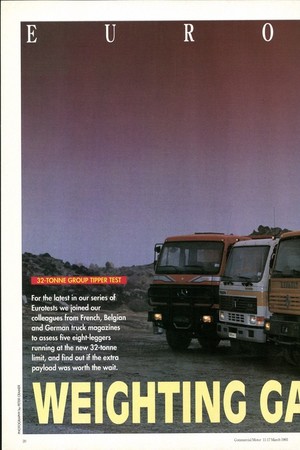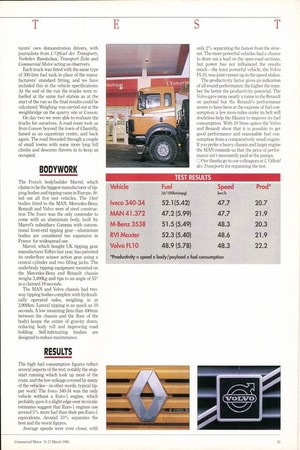WEIGHING G
Page 22

Page 23

Page 24

Page 25

If you've noticed an error in this article please click here to report it so we can fix it.
For the latest in our series of Eurotests we joined our colleagues from French, Belgian and German truck magazines to assess five eight-leggers running at the new 32-tonne limit, and find out if the extra payload was worth the wait.
ight-leggers have always been as much a Great British dish as roast beef and Yorkshire pudding, and since January's gross weight increase from 30.49 to 32 tonnes they're back in the spotlight. But we're not the only European country with a taste for four-axle rigids.
The Dutch and the Germans use them and 8x4s are catching on in France. When our colleagues at L'Officiel des Transports magazine decided to hold a Eurotest of five 8x4s we hot-footed it over to Le Bourget, on the northern outskirts of Paris, along with testers from Verkehrs Rundschau of Germany and Transport Echo of Belgium.
Why go to France? For a start it's taken a while for UK manufacturers and importers to feed heavier eight-leggers into their test fleets. Also, as our Eurotest rivals are all running at 32 tonnes we've been able to come up with some hard facts on higher weights early on in the game.
Many of these models are similar, if not identical, to UK models and all of them barring the Iveco 340-34AH are specified with low-emission Euro-1 engines so our results stand comparison with UK chassis.
III Our usual practice on Eurotests is to spend two days on a test route to obtain the fuel consumption, speed and productivity results. When our French colleagues at L'Officiel des Transports chose tippers for their test this year, we decided that lengthy routes would not be representative of their normal operating conditions—CM's tipper route is the shortest of our heavy truck test routes. Instead we opted for a short run offering a mixture of stop-start urban and A-road running with some hillclimbs thrown in for good measure.
TEST ROUTE Our route started at Le Bourget airport on the outskirts of Paris. It's outside the notorious Peripherique ring road, which approximates to the Parisian M25, so we were able to avoid the worst of the city traffic. After fuelling we passed Charles de Gaulle airport on a short section of dual carriageway before turning on to single-carriageway roads which took us through the north-eastern suburbs of the French capital.
The typical urban conditions included lots of traffic lights and narrow congested roads with cars parked along both sides. Having left the suburbs the route finished on open singlecarriageway roads with a long hillclimb and descent to a quarry and landfill site at the small town of Cosson 22km (13.7 miles) from the starting point at Le Bourget.
The trucks turned round here and retraced the route to Le Bourget, giving a total run of 44km (27 miles). The route was repeated twice more to give a total distance of 132km (82.1 miles). Driving was left to the manufacturers' own demonstration drivers, with journalists from L'Officiel des Transports, Verkehrs Rundschau, Transport Echo and Commercial Motor acting as observers.
Each truck was fitted with the same type of 300-litre fuel tank in place of the manufacturers' standard fitting, and we have included this in the vehicle specifications. At the end of the run the trucks were refuelled at the same fuel station as at the start of the run so the final results could be calculated. Weighing was carried out at the weighbridge on the quarry site at Cosson.
On day two we were able to evaluate the trucks for ourselves. A road route took us from Cosson beyond the town of Chantilly, famed as an equestrian centre, and back again. The road threaded through a couple of small towns with some more long hill climbs and descents thrown in to keep us occupied.
BODYWORK The French bodybuilder Marrel, which claims to be the biggest manufacturer of tipping bodies and tipping rams in Europe, fitted out all five test vehicles. The 14m' bodies fitted to the MAN, Mercedes-Benz, Renault and Volvo were of steel construction The Iveco was the only contender to come with an aluminium body, built by Marrel's subsidiary Comena with conventional front-end tipping gear—aluminium bodies are considered too expensive in France for widespread use.
Marrel, which bought UK tipping gear manufacturer Edbro last year, has patented its underfloor scissor action gear using a central cylinder and two lifting jacks. The underbody tipping equipment mounted on the Mercedes-Benz and Renault chassis weighs 3,400kg and tips to an angle of 55° in a claimed 19 seconds.
The MAN and Volvo chassis had twoway tipping bodies complete with hydraulically operated sides, weighing in at 3,900Iun. Lateral tipping is as quick as 10 seconds. A low mounting (less than 400mm between the chassis and the floor of the body) keeps the centre of gravity down, reducing body roll and improving road holding. Self-lubricating bushes are designed to reduce maintenance.
RESULTS The high fuel consumption figures reflect several aspects of the test; notably the stopstart running which took up most of the route, and the low mileage covered by many of the vehicles—in other words, typical tipper work! The Iveco 340-34 was the only vehicle without a Euro-1 engine, which probably gave it a slight edge over its rivals: estimates suggest that Euro-1 engines use around 5% more fuel than their pre-Euro-1 equivalents. Around 10% separates the best and the worst figures.
Average speeds were even closer, with only 2% separating the fastest from the slowest. The more powerful vehicles had a chance to draw out a lead on the open-road sections, but power has not influenced the results much—the least powerful vehicle, the Volvo FL10, was joint runner-up in the speed stakes.
The productivity factor gives an indication of all-round performance; the higher the number the better the productivity potential. The Volvo gave away nearly a tonne to the Renault on payload but the Renault's performance seems to have been at the expense of fuel consumption: a few more miles under its belt will doubtless help the Maxter to improve its fuel consumption. With 10 litres apiece the Volvo and Renault show that it is possible to get good performance and reasonable fuel consumption from a comparatively small engine. If you prefer a heavy chassis and larger engine the MAN reminds us that the price of performance isn't necessarily paid at the pumps.
Our thanks go to our colleagues at L'Officiel des Transports for organising the test.
TEST RESULTS Vehicle Fuel Lit/ 100km(mpg) Speed km/h Prod* Iveco 340-34 52.1(5.42) 47.7 20.7 MAN 41.372 47.2 (5.99) 47.7 21.9 M-Benz 3538 51.5 (5.49) 48.3 20.3 RVI Maxter 52.3 (5.40) 48.6 21.9 Volvo FL10 48.9 (5.78) 48.3 22.2
















































































